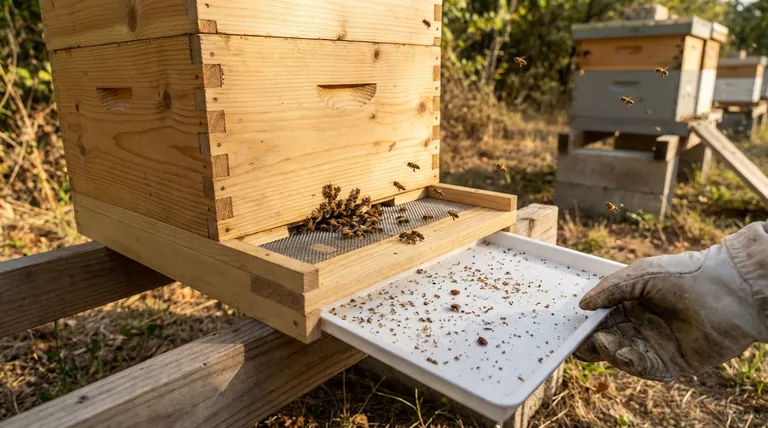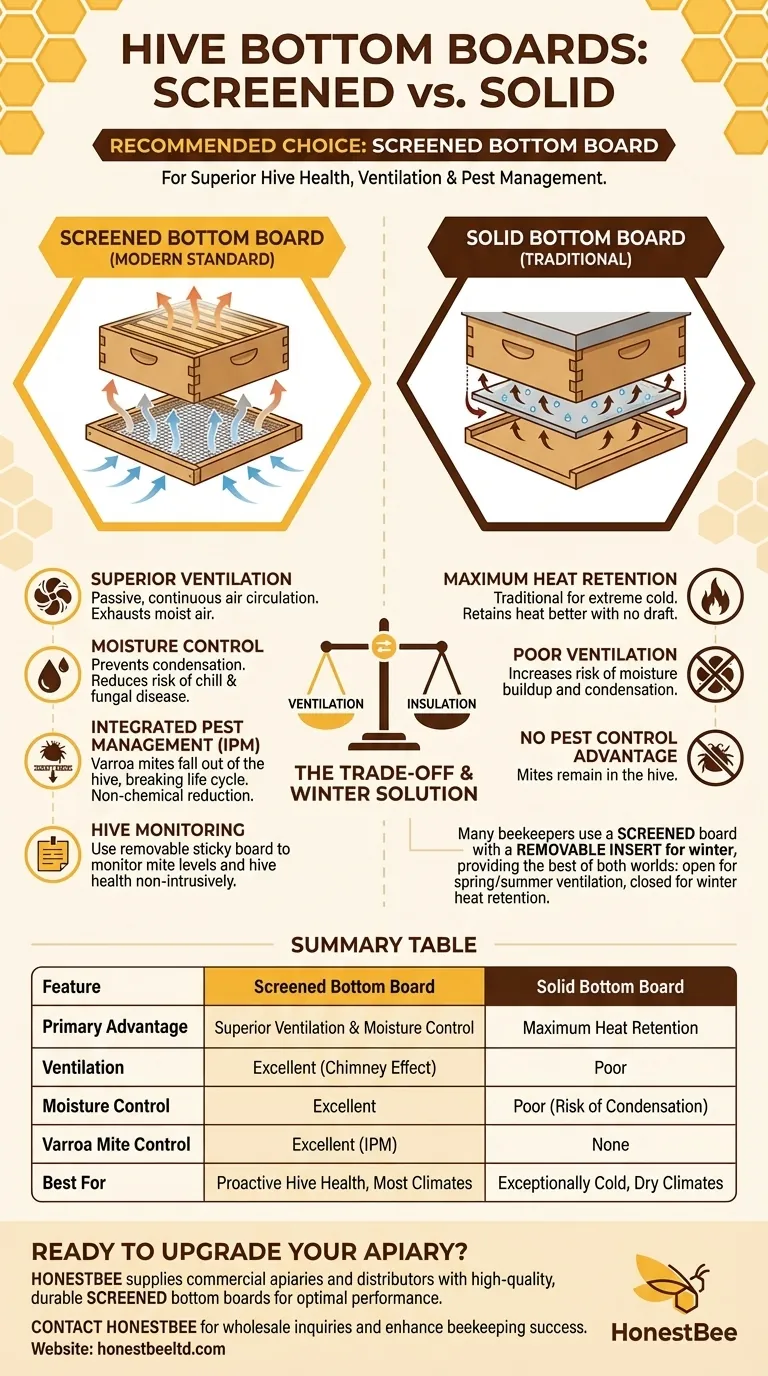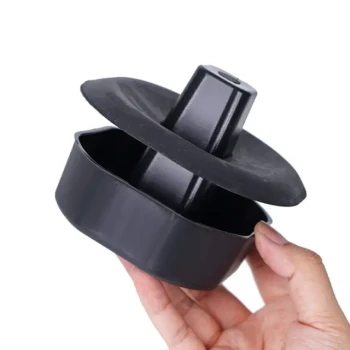For most beekeepers, the recommended choice is a screened bottom board. This design provides significant advantages for hive health by improving ventilation, helping to control moisture, and aiding in the management of Varroa mites. While a solid bottom board is the traditional option, the benefits of a screened bottom board make it the modern standard for proactive hive management.
The decision between a solid and screened bottom board is fundamentally about controlling the hive's internal environment. A screened bottom board gives the beekeeper a powerful tool for managing ventilation and pests, which are two of the most critical factors for colony survival.
The Purpose of a Hive Bottom Board
A bottom board is the floor of the beehive. It serves as the base upon which the hive bodies rest and provides the primary entrance and exit for the bees. Its design, however, has a significant impact on the conditions inside the hive.
The Case for Screened Bottom Boards
The strong recommendation for screened bottom boards stems from their ability to solve several common beekeeping challenges simultaneously.
Superior Ventilation
A screened bottom allows for passive, continuous air circulation. As the bees fan and warm air rises, fresh, dry air is drawn up from below, creating a chimney effect that exhausts moist air out through the top of the hive.
Moisture and Condensation Control
Moisture is a major threat to a colony, especially in winter. When warm, moist air from the bees' respiration hits a cold inner surface, it condenses into water. A screened bottom board allows this moisture-laden air to escape before it can condense and drip down on the cluster, which can chill and kill bees.
Integrated Pest Management (IPM)
This is one of the most significant advantages. Varroa mites, a devastating parasite, periodically fall off their host bees. With a screened bottom board, a percentage of these mites fall completely out of the hive, breaking their life cycle and reducing the overall mite population without chemical intervention.
Hive Monitoring
A screened bottom board allows you to place a removable white board (often called a "sticky board") underneath the screen. By examining the debris that falls onto the board, you can monitor mite levels, check for pollen collection, and get a general sense of the colony's health without disruptive inspections.
Understanding the Trade-offs
While screened bottom boards are widely recommended, it's crucial to understand their trade-offs compared to traditional solid boards. Objectivity requires acknowledging situations where a solid board might be considered.
Solid Boards: The Traditional Approach
Solid bottom boards are simpler in construction. Their primary advantage is maximum heat retention, as there is no screen for air to pass through. In theory, this helps the colony stay warm during extremely cold winters with less effort.
The Central Conflict: Ventilation vs. Insulation
The core trade-off is between ventilation and insulation. A screened board prioritizes ventilation at the cost of some heat loss. A solid board prioritizes heat retention at the cost of poor ventilation, which increases the risk of moisture buildup and related fungal diseases.
Winter Management: The Best of Both Worlds
Many beekeepers resolve this conflict by using a screened bottom board that includes a removable insert or "slider." This allows you to have an open screen for ventilation during the active spring and summer months and then slide the insert in to close off the bottom during the coldest parts of winter, effectively turning it into a solid board when heat retention is most critical.
Making the Right Choice for Your Hive
Your decision should be based on your climate, management style, and primary goals for your colony's health.
- If your primary focus is hive health and proactive Varroa mite control: A screened bottom board is the definitive choice for its ventilation and pest management benefits.
- If you want maximum flexibility and control: A screened bottom board with a removable insert provides the best of both worlds, allowing you to adjust ventilation seasonally.
- If you are in an exceptionally cold, dry climate and prioritize heat retention above all: A solid board can work, but you must be vigilant in providing other means of ventilation to prevent deadly condensation.
Ultimately, your bottom board is your primary tool for managing the hive's internal atmosphere, and a screened design offers the most control.

Summary Table:
| Feature | Screened Bottom Board | Solid Bottom Board |
|---|---|---|
| Primary Advantage | Superior Ventilation & Moisture Control | Maximum Heat Retention |
| Ventilation | Excellent (Chimney Effect) | Poor |
| Moisture Control | Excellent | Poor (Risk of Condensation) |
| Varroa Mite Control | Excellent (Integrated Pest Management) | None |
| Best For | Proactive Hive Health, Most Climates | Exceptionally Cold, Dry Climates |
Ready to upgrade your apiary's health and efficiency? HONESTBEE supplies commercial apiaries and beekeeping equipment distributors with high-quality, durable screened bottom boards designed for optimal hive performance. Our wholesale-focused operations ensure you get the best equipment to manage ventilation, control pests, and support strong colonies. Contact HONESTBEE today to discuss your wholesale needs and enhance your beekeeping success.
Visual Guide

Related Products
- Langstroth Screen Bottom Board for Beekeeping Wholesale
- Australian Pine Wood Langstroth Screen Bottom Board for Wholesale
- Langstroth Solid Bottom Board for Beekeeping
- Professional Ant-Proof Beehive Stand with Integrated Moat for Beekeeping
- Boardman Entrance Bee Feeder Durable Galvanized Steel and Wood Construction for Beekeeping
People Also Ask
- What are the benefits of using a screened bottom board for beehives? Improve Ventilation & Mite Control
- What are the assembly options for the Cypress Screened Bottom Board? Ready-to-Use for Immediate Hive Health
- How should the screened bottom board be used throughout the year? A Guide for Healthy Hives
- What are the main benefits of using a Screened Bottom Board in beekeeping? Enhance Hive Health & Productivity
- What are the benefits of a screened bottom board? Boost Hive Health & Control Varroa Mites



















